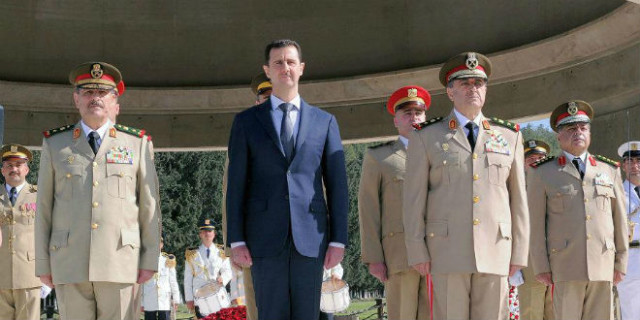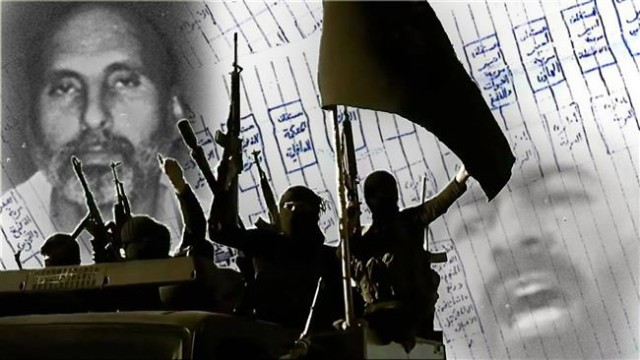Are we witnessing the end of Syria?
 Reuters has a report on how Quds Force Commander Gen. Soliemani mapped out Russian involvement to save beleaguered Syrian President Bashar Assad, “How Iranian general plotted out Syrian assault in Moscow.” The strategy unraveling now is a joint air and ground assault to carve out an Alawite bastion in Western and Northwestern Syria ejecting CIA and Coalition-trained opposition, Al Qaeda Al Nusrah Front and Free Syrian Army forces. The air assault to date has focused on attacking these units in a strategic line north out of Damascus. The ground component is composed of fresh Revolutionary Guards and Hezbollah units. The Russian air assault contingent based in Latakia province is being bolstered by Russian “volunteers” a page out of Putin’s playbook for seizure of the Crimea and invasion of Eastern Ukraine. In the absence of significant US trained Sunni opposition contingents in this scenario; it would appear that Syria may devolve into a series of sectarian cantons akin to the French Mandate for Syria granted by the League of Nations in the early 1920’s.
Reuters has a report on how Quds Force Commander Gen. Soliemani mapped out Russian involvement to save beleaguered Syrian President Bashar Assad, “How Iranian general plotted out Syrian assault in Moscow.” The strategy unraveling now is a joint air and ground assault to carve out an Alawite bastion in Western and Northwestern Syria ejecting CIA and Coalition-trained opposition, Al Qaeda Al Nusrah Front and Free Syrian Army forces. The air assault to date has focused on attacking these units in a strategic line north out of Damascus. The ground component is composed of fresh Revolutionary Guards and Hezbollah units. The Russian air assault contingent based in Latakia province is being bolstered by Russian “volunteers” a page out of Putin’s playbook for seizure of the Crimea and invasion of Eastern Ukraine. In the absence of significant US trained Sunni opposition contingents in this scenario; it would appear that Syria may devolve into a series of sectarian cantons akin to the French Mandate for Syria granted by the League of Nations in the early 1920’s.
The objective of Iran is to build a virtual Shia crescent from the Persian Gulf to the Mediterranean coast including bringing in Shia extremist Imams and resettling Shia refugees from Afghanistan and Pakistan in Syrian areas depopulated of Sunnis and Christians. The Alawites, who are secular, are troubled by this development and many have fled abroad. The Kurds have their de facto canton in Northeastern Syria abutting the Kurdish Regional Government in neighboring Iraq.
Turkey is clearly upset with the Russian presence in Syria, as is NATO, while the US is clearly dithering on what to do. Once again Obama has been outfoxed by Soliemani and Putin. That leaves allies like Israel, the Saudis and the Emirates seeking alternatives for their own sovereign protection. The Saudis and Emirates are talking about a jihad akin to that they funded in Afghanistan with CIA and Pakistan’s ISI in a secret war in the 1980’s that led to the rout of the Soviet 40th Army and gave rise to Bin Laden’s Al Qaeda.
A Der Spiegel article, “The Iranian Project: Why Assad Has Turned to Moscow for Help” portrays President Bashar al-Assad as caught in a dilemma; “fear of friends”, meaning Iran versus “fear of opposition.”That former fear stems from reliance on Iran Revolutionary Guards, Shia auxiliaries from Hezbollah in Lebanon, the Sadr Brigade in Iraq and Shia fighters from Afghanistan and Pakistan. They are under the command of Quds Force Commander Soliemani and make up for the decimation and desertions of draftees from the Syrian National Defense Forces. Iran’s intention is to build an Islamic Revolutionary State within the areas along the Mediterranean coast and Mountains of Northwest Syria. To that end Iran has sent in radical Imams to create Shia religious centers directed at conversion of secular Alawites and Sunnis causing them to flee the country. Thus, Assad has welcomed the Russia military assistance as Putin has allegedly no such interests in the current campaign, excepting protecting Russian interests in naval and military bases, as well as offshore gas developments.
Note these excerpts:
“Assad and those around him are afraid of the Iranians,” the Russian says. Anger over the arrogance of the Iranians, who treat Syria like a colony, is also part of it, the Russian continues. Most of all, though, the Syrians “mistrust Tehran’s goals, for which Assad’s position of power may no longer be decisive. That is why the Syrians absolutely want us in the country.”
Tehran’s goals go far beyond merely reestablishing the status quo in Syria. In early 2013, Hojatoleslam Mehdi Taeb, one of the planners behind Iran’s engagement in Syria, said: “Syria is the 35th province of Iran and it is a strategic province for us.” For several decades, the alliance between the Assads and Iran was a profitable one, particularly in opposition to the Iraq of Saddam Hussein, which long had the upper hand in the region. But today, Assad depends on Iran to remain in power, and Tehran is taking advantage of the situation.
It is, however, primarily in the civilian sector where significant changes are afoot. Just as in Damascus, Latakia and Jabla, increasing numbers of hosseiniehs — Shiite religious teaching centers — are opening. The centers are aimed at converting Sunnis, and even the Alawites, the denomination to which the Assads belong, to “correct” Shiite Islam by way of sermons and stipends. In addition, the government decreed one year ago that state-run religion schools were to teach Shiite material.
All of this is taking place to the consternation of the Alawites, who have begun to voice their displeasure. “They are throwing us back a thousand years. We don’t even wear headscarves and we aren’t Shiites,” Alawites complained on the Jableh News Facebook page. There were also grumblings when a Shiite mosque opened in Latakia and an imam there announced: “We don’t need you. We need your children and grandchildren.”
Talib Ibrahim, an Alawite communist from Masyaf who fled to the Netherlands many years ago, summarizes the mood as follows: “Assad wants the Iranians as fighters, but increasingly they are interfering ideologically with domestic affairs. The Russians don’t do that.”
Putin may have been prompted by Quds Force Commander Soliemani to aid mutual client Assad because he saw an opportunity to make a power play against the US in the region. However, the secular Ba’athist Syrian tradition has been virtually suborned by the influx of Iranian Revolutionary Guards ‘and Shia proxies’ with the objective of creating a Khomeinist Revolutionary state. The confluence of those opposing interests, secular and religious, may ultimate end the decades’ long rule of the Assad family. That might lead to an ultimate apocalyptic conflict in Syria between nuclear equipped Shia Iran and the Sunni Salafist Islamic State.


